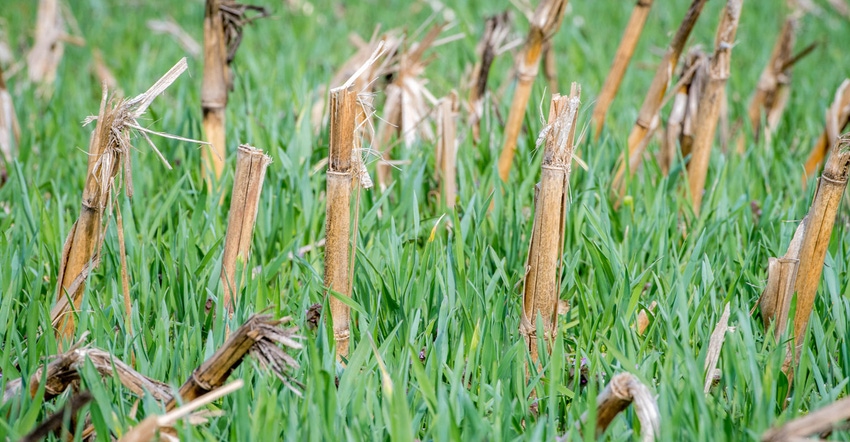
Rob Myers grew up on a farm. He’s seen firsthand the challenges that arise from extreme weather.
“Whether it’s flooding from excessive rain or drought from not enough rain, climate change ultimately impacts our food production and food prices,” Myers says. “Our goal is to help farmers with different practices that will make their farms more resilient.”
Myers is the director of the Center for Regenerative Agriculture at the University of Missouri and an adjunct professor in MU’s College of Agriculture, Food and Natural Resources. For the next five years, he will oversee a $25 million USDA Partnerships for Climate-Smart Commodities Program for the state’s farmers and ranchers.
The collaborative grant includes partnerships with the Center for Regenerative Agriculture, MU Extension, the MU Center for Agroforestry, Lincoln University, Missouri Corn Growers Association, Missouri Soybean Association, Missouri Cattlemen’s Association, state agencies, agribusiness nonprofit groups in Missouri and 14 faculty in CAFNR.
One of the main goals of the grant is to get more carbon out of the atmosphere and into the soil, with an expected reduction of 1 million metric tons in carbon dioxide equivalents — comparable to offsetting the emissions of more than 200,000 cars.
For Myers, the climate-smart grant will encourage and enhance stewardship practices on the farm through education, incentives and marketing.
Conservation add-ons for crops
Missouri farmers are no strangers to incorporating one climate-smart practice — cover crops. The 2017 Census of Agriculture has the state planting 850,000 acres of cover crops. Myers contends farmers can manage those acres differently and get paid.
Currently, there are cover crop payments available from both the Natural Resources Conservation Service and Missouri Soil and Water Conservation Program. “One of several approaches we’ll be supporting with this program, in an effort to promote even further buildup of soil organic matter and soil carbon, is giving farmers an extra payment for terminating the cover crops late, what we call ‘planting green,’” Myers explains.
Planting green refers to keeping cover crops on the field longer in the spring. Then instead of killing it early then planting, farmers sow straight into the cover crop. Adding this slight crop management adjustment can result in an additional payment beyond the traditional cover crop payment. Myers says there is also an option for those farmers who choose to have livestock graze off those cover crops.
Funds for livestock practices
A new climate-smart initiative for livestock producers in the state will be the Grow Your Edge program.
This allows farmers with existing pastures to plant trees along the pasture or field edges to create shade for livestock, which also builds up carbon in the soil. According to Myers, while NRCS already has a variety of tree planting programs, this will “be complementary of other programs in the state. It adds a little different type of payment.”
Other funding will be available to support Management-intensive Grazing approaches, along with planting more diverse pastures to extend grazing periods.
Myers adds that farmers can take advantage of educational workshops to learn more about regenerative grazing options.
Nutrient management enhancements
Working with several partners, MU will also work to support nutrient management improvements.
Farmers can receive incentives for grid soil sampling and precision nutrient management that fits with the 4R approach for fertilizers. Precision application of manure will also be supported.
Expansive program reach
While many of the climate-smart programs being touted focus on large-scale agriculture, Myers says there is truly something for all farm sizes.
“If you have a 5-acre horticulture operation or a 10-acre viticulture operation or small-scale livestock, there are additional options, what we’re calling Climate-Smart Fieldscapes,” he explains. “These smaller farms can choose from a suite of different conservation practices, do three of those practices on their farm and receive a flat-rate payment. We'll also use some of those farms for field days and demonstrations.”
Myers expects close to 100 of those small farms across the state to take part in climate-smart solutions.
When to enroll
The MU Climate-Smart Commodity Program is a five-year project. Myers says that at any point in the five years, farmers can sign up, but funding is on a first-come, first-served basis.
The project itself is still waiting on an official start date, but Myers estimates rollout after January. “We are looking at signing up farmers to do practices in the fall of 2023 and beyond,” he says.
Myers encourages farmers to research the climate-smart projects and see what makes sense for their particular operation. Not all payments in the Missouri climate-smart partnerships will piggyback on carbon payments with private companies.
“Farmers need to be aware of the rules for both programs," he adds, “and that is where we can help with during our educational programs. We can help work through the choices that add the most value to their operation.”
The Center for Regenerative Agriculture and its partners will keep farmers informed about Climate-Smart Commodity Programs and timelines. Myers says farmers can also sign up for the center’s email newsletter at the Center for Regenerative Agriculture website.
Marketing climate-smart practices
One goal for USDA is for grant awardees to expand market opportunities for farmers through climate-smart practices. Myers says a portion of the $25 million awarded to MU will target market development.
“There's interest from different groups, not only from consumers, but also from different food and ag companies to see certain climate-related practices used with their end product,” he explains. “We help the farmers capture value from that, so that it's not just a company that's making money from soil carbon, but that the farmers are getting some value.”
About the Author(s)
You May Also Like






